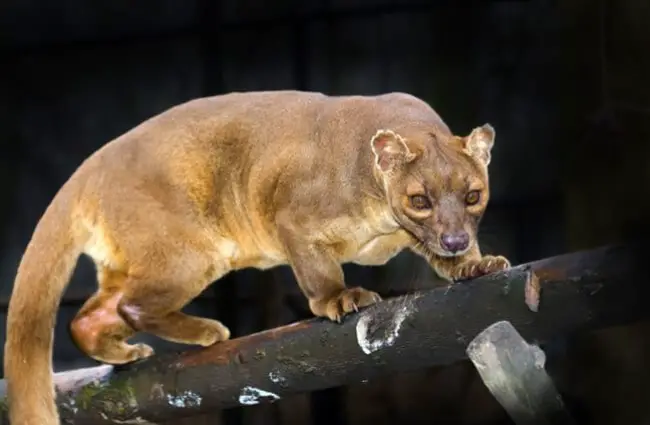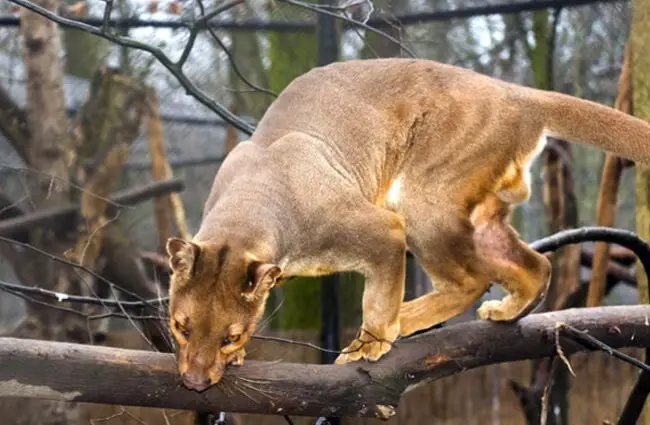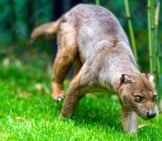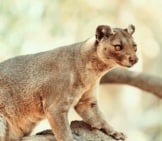The fossa is a predatory mammal native to the island of Madagascar. They slightly resemble cats, but are actually more closely related to mongoose. These medium-sized animals are the largest predators on the island. Read on to learn about the fossa.
Description of the Fossa
These cat-like predators have been equated to miniature cougars. They have slender bodies, muscular limbs, and very long tails. Their fur is dark or golden brown, and is solid in color.
These creatures have a slightly elongated head with a short, broad, muzzle and round ears. Males of the species are slightly longer and heavier than females. Younger animals are usually lighter in color, ranging from grey to nearly white.
Interesting Facts About the Fossa
Fossae are skillful predators, and uniquely adapted for hunting and living in the treetops. They are equipped with a number of tools to help them climb, balance, and kill.
- Tip Top Tail – When living in the trees, animals must have good balance or risk a potentially fatal fall. One common adaptation to aid in this danger is the use of a tail for balance. Fossae have tails that are nearly as long as their body. This provides great counterbalance when walking along branches.
- Cat-Like Claws – While fossae are not closely related to cats, they do share a common trait – retractable claws. Most members of the mongoose family have non-retractable claws that they use for digging. Unlike their relatives, fossae use semi-retractable claws to grip tree branches.
- Sole Power – Their feet are also uniquely designed for climbing in other ways. Rather than having fur on the soles of their paws to silence the sound of walking, these creatures have nearly bare paws. This gives them extra grip when climbing branches.
- Flexible Feet – Another wonderful adaptation in their feet is the ability to rotate their ankles. They have extremely flexible joints in their paws. This allows these arboreal predators to climb up and down trees headfirst with ease.
Habitat of the Fossa
These animals can be found over nearly the entire island of Madagascar. They are found in greater population densities in areas of undisturbed forest. Some can also survive in degraded forests, but at much lower numbers. Fossae can be found in virtually every type of forest habitat on Madagascar, including southern spiny, rainforest, and dry deciduous forests.
Distribution of the Fossa
The natural range of fossae is restricted to the island of Madagascar. They are found across most of the island, but restricted to forested areas. They cannot be found anywhere else in the world, outside of zoological institutions.
Diet of the Fossa
Of all Madagascan carnivores, fossae are the largest and the only predator capable of consuming all lemur species. They prefer small to medium-sized prey items, but have been known to hunt the largest lemur species. Lemurs are their most common prey item, followed by tenrecs, reptiles, birds, and insects.
Seeds have also been found in fossae feces, but scientists are unsure if this is due to direct consumption, or if they were in the stomachs of the lemurs consumed. These cat-like mammals will hunt both on the ground and in the trees.
Fossa and Human Interaction
Unfortunately, as opportunistic carnivores, fossae will prey upon livestock if given the opportunity. They have been known to eat young goats and cows, and commonly prey on chickens. This can cause conflict between the farmers and the predators, leading to retaliation poaching.
Sadly, the impact of hunting is extrapolated by habitat destruction. These predators can only hunt in dense forests, causing severe population decline in areas subject to deforestation and farming. This leads to more fossae hunting livestock.
Domestication
There is no known record of these animals being domesticated in any way.
Does the Fossa Make a Good Pet
Because they are a protected species, it is illegal to own a fossa as a pet. They are also powerful carnivores that could pose a danger as a pet.
Fossa Care
In zoos, these creatures are provided with plenty of exhibit space for exercise. They require many different opportunities for climbing and jumping, and enjoy napping on raised platforms. In a zoological setting these predators are fed dried cat food, a commercially prepared carnivore meat diet, mice, rats, and large knucklebones.
Behavior of the Fossa
These solitary predators develop home territories. During the breeding season they have been known to hunt as pairs, but typically range and hunt alone. They utilize scent marking to establish territory boundaries, and use glands on their chest and tail for this purpose. Territories very rarely overlap.
Reproduction of the Fossa
When breeding season rolls around, females begin to vocalize their readiness to mate. Males will battle and vocalize at one another for the right to breed with a female. Surprisingly, reproduction of the fossa seems to occur in the same area, and even in the same tree, year after year.
Once the female has chosen a male and bred with him, she will give birth to between one and six pups after a three-month gestation period. She builds a den and raises the cubs on her own. Fossa pups will not leave the den until they are at least four months old, and they are weaned shortly after. The pups may remain with their mother until they are nearly four years old.
Beliefs, Superstitions, and Phobias About the Fossa
There are a number of myths about fossae in the native cultures of Madagascar. Many of these tales were negative, and reflect the common conflict between these predators and humans. One tale claims that the scent of these creatures alone can kill poultry, and another claims that they sneak into homes and steal babies straight from the crib. These are, of course, all untrue.











![Red Angus Closeup of a beautiful Red Angus cowPhoto by: U.S. Department of Agriculture [pubic domain]https://creativecommons.org/licenses/by/2.0/](https://animals.net/wp-content/uploads/2020/03/Red-Angus-4-238x178.jpg)












![Red Angus Closeup of a beautiful Red Angus cowPhoto by: U.S. Department of Agriculture [pubic domain]https://creativecommons.org/licenses/by/2.0/](https://animals.net/wp-content/uploads/2020/03/Red-Angus-4-100x75.jpg)

